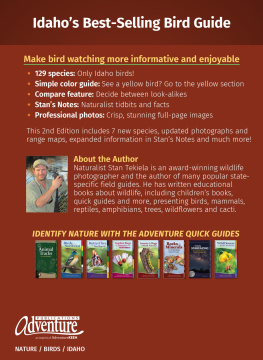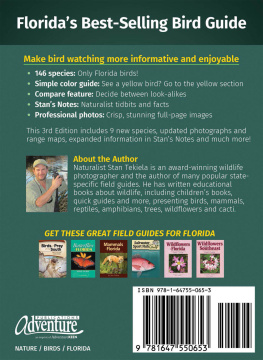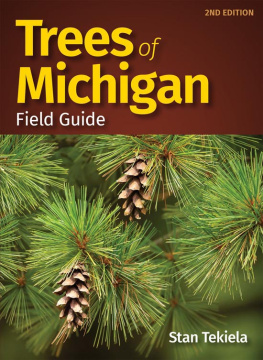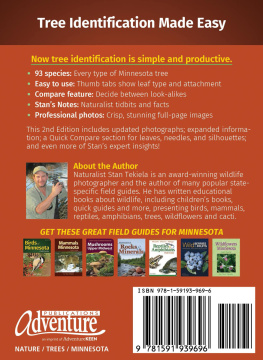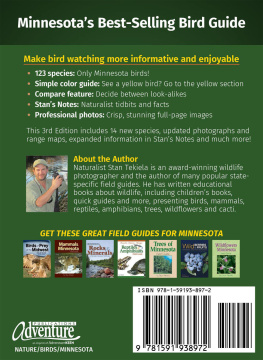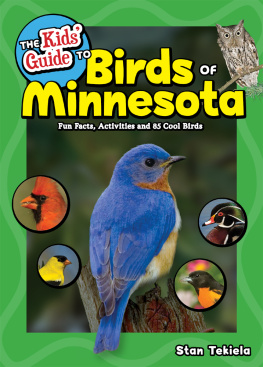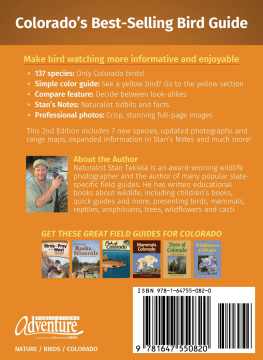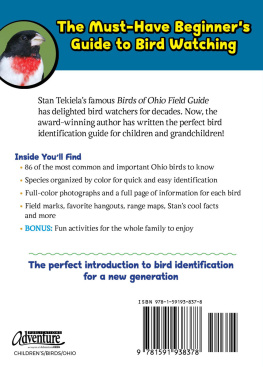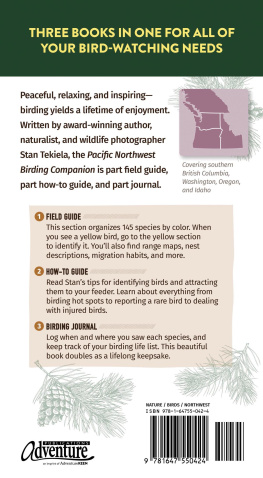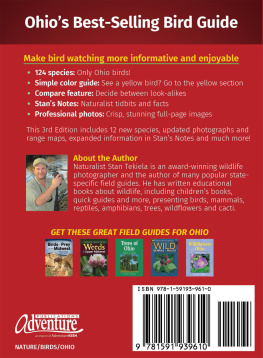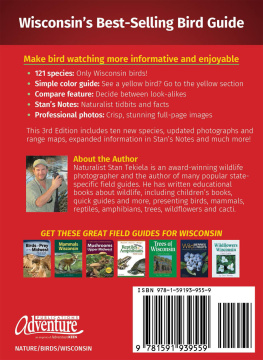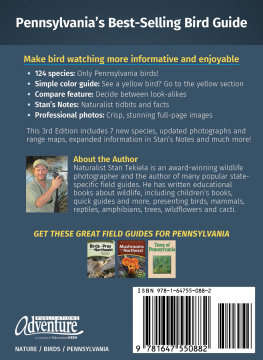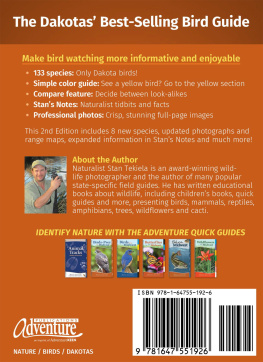

Edited by Sandy Livoti and Dan Downing
Cover, book design and illustrations by Jonathan Norberg
Range maps produced by Anthony Hertzel
Cover photo: Varied Thrush by Stan Tekiela
All photos by Stan Tekiela except (female) by Jim Zipp.
To the best of the publishers knowledge, all photos were of live birds. Some were photographed in a controlled condition.
1 0 9 8 7 6 5 4 3 2 1
Birds of Idaho Field Guide
First Edition 2003
Second Edition 2022
Copyright 2003 and 2022 by Stan Tekiela
Published by Adventure Publications
An imprint of AdventureKEEN
310 Garfield Street South
Cambridge, Minnesota 55008
(800) 678-7006
www.adventurepublications.net
All rights reserved
Printed in China
ISBN 978-1-64755-148-3 (pbk.); ISBN 978-1-64755-149-0 (ebook)
WHATS NEW?
It is hard to believe that its been nearly 20 years since the debut of Birds of Idaho Field Guide . This critically acclaimed field guide has helped countless people identify and enjoy the birds that we love. Now, in this expanded second edition, Birds of Idaho Field Guide has many new and exciting changes and a fresh look, while retaining the same familiar, easy-to-use format.
To help you identify even more birds in Idaho, I have added 7 new species and more than 150 new color photographs. All of the range maps have been meticulously reviewed, and many updates have been made to reflect the ever-changing movements of the birds.
Everyones favorite section, Stans Notes, has been expanded to include even more natural history information. Compare sections have been updated to help ensure that you correctly identify your bird, and additional feeder information has been added to help with bird feeding. I hope you will enjoy this great new edition as you continue to learn about and appreciate our Idaho birds!

WHY WATCH BIRDS IN IDAHO?
Millions of people have discovered bird feeding. Its a simple and enjoyable way to bring the beauty of birds closer to your home. Watching birds at your feeder often leads to a lifetime pursuit of bird identification. The Birds of Idaho Field Guide is for those who want to identify the common birds of Idaho.
There are over 1,100 species of birds found in North America. In Idaho alone there have been more than 350 different kinds of birds recorded throughout the years. These bird sightings were diligently recorded by hundreds of bird watchers and became part of the official state record. From these valuable records, Ive chosen 129 of the most common birds of Idaho to include in this field guide.
Bird watching, often called birding, is one of the most popular activities in America. Its outstanding appeal in Idaho is due, in part, to an unusually rich and abundant birdlife. Why are there so many birds? One reason is open space. Idaho is over 80,500 square miles (209,300 sq. km), making it the fourteenth-largest state. Despite its large size, only about 1.75 million people call Idaho home. On average, that is only 22 people per square mile (8 per sq. km). Most of these people are located in and around only three major cities.
Open space is not the only reason there is such an abundance of birds. It is also the diversity of habitat. Idaho can be broken into three distinct habitatsRocky Mountains, Columbia Plateau, and Basin and Range Provinceeach of which supports a different group of birds.
The Rocky Mountains make up more than half of Idahos entire land mass. Elevations from the lowest valley floor to the tallest peak in the stateMount Borahrange from approximately 4,000 to 12,650 feet (1,200 to 3,850 m). Located mainly in the central part of the state, the Rockies are home to birds such as Mountain Chickadees and American Dippers.
The Columbia Plateau lies in the southern part of the state just south of the Rocky Mountains. It is a diverse area, with the Snake River Plain making up most of its features. This wide river plain is the most inhabited region in Idaho and is home to birds such as Mountain Bluebirds and Green-tailed Towhees.
Within the Columbia Plateau is a small region called the Basin and Range Province. Elevations here range from 4,000 to 6,000 feet (1,200 to 1,850 m). With its many valleys and rivers, this area is mostly agricultural. It is a good place to see such birds as Lark Sparrows and California Quail.
Idaho also has more than 20.4 million acres (8.2 million ha) of national forestland. Ruffed Grouse, Coopers Hawks, owls and many other bird species are attracted to these wild, richly wooded reserves.
There are many large lakes in Idaho, most of which are located in the Panhandle. One of these is Lake Pend Oreille. Covering 133 square miles (346 sq. km), it is the states largest lake. Rivers that swell with snowmelt from the Rocky Mountains feed Idaho lakes each spring. Idaho also has many reservoirs. Water birds such as Pied-billed Grebes and Western Grebes are attracted to these bodies of water.
Not only does Idaho have varying habitats, it also has variations in the weather. Since the state extends over 480 miles (773 km) from north to south, the weather ranges greatly. The Rockies in central Idaho create a moisture barrier, which results in a rain shadow effect in southern Idaho, making it much drier there. Southwestern Idaho is the warmest part of the state, while the Panhandle in the northwest is the coldest.
Whatever the elevation or weather, there are birds to watch in each season. Whether witnessing a migration of hawks in the fall or welcoming back hummingbirds in spring, there is variety and excitement in birding as each season turns to the next.
OBSERVE WITH A STRATEGY; TIPS FOR IDENTIFYING BIRDS
Identifying birds isnt as difficult as you might think. By simply following a few basic strategies, you can increase your chances of successfully identifying most birds that you see. One of the first and easiest things to do when you see a new bird is to note its color. This field guide is organized by color, so simply turn to the right color section to find it.
Next, note the size of the bird. A strategy to quickly estimate size is to compare different birds. Pick a small, a medium and a large bird. Select an American Robin as the medium bird. Measured from bill tip to tail tip, a robin is 10 inches (25 cm). Now select two other birds, one smaller and one larger. Good choices are a House Sparrow, at about 6 inches (15 cm), and an American Crow, around 18 inches (45 cm). When you see a species you dont know, you can now quickly ask yourself, Is it larger than a sparrow but smaller than a robin? When you look in your field guide to identify your bird, you would check the species that are roughly 610 inches (1525 cm). This will help to narrow your choices.
Next, note the size, shape and color of the bill. Is it long or short, thick or thin, pointed or blunt, curved or straight? Seedeating birds, such as Evening Grosbeaks, have bills that are thick and strong enough to crack even the toughest seeds. Birds that sip nectar, such as Broad-tailed Hummingbirds, need long, thin bills to reach deep into flowers. Hawks and owls tear their prey with very sharp, curving bills. Sometimes, just noting the bill shape can help you decide whether the bird is a woodpecker, finch, grosbeak, blackbird or bird of prey.
Next page
